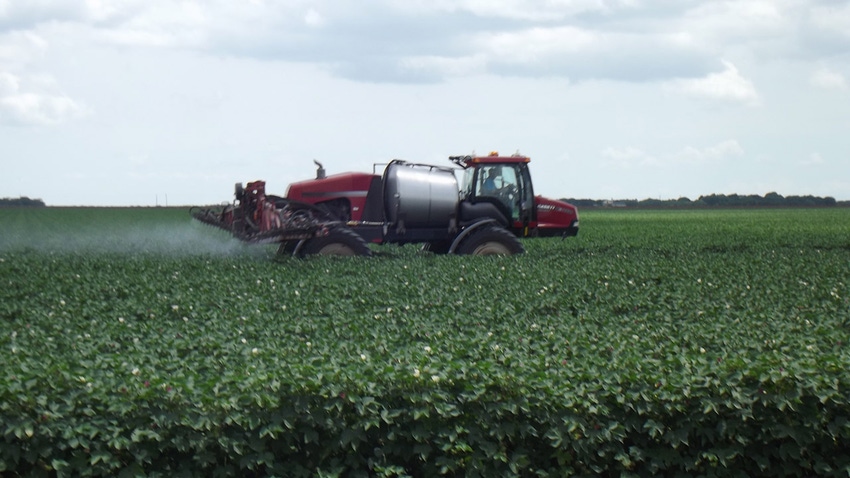
Good soil moisture in the southern half of Texas keeps most remain optimistic for the current growing season, but heavy spring rainfall created a handful of problems for farmers in the region who are still dealing with the aftershock of flooded fields and late planting dates.
As grain sorghum harvest intensifies from the middle Coastal Bend into the Lower Rio Grande Valley, farmers see stunted plants and damage for corn and sorghum in many fields, especially in the middle and upper Coastal Bend where spring rainfall totaled from 5 to 20 inches from March through the first half of June.
In spite of spotty crop damage, early harvest reports indicate grain sorghum and corn yields have been average to good in most fields. But the combination of a wet spring and current grain harvest has many cotton producers concerned because of a rise in pest and disease pressure, especially in more mature cotton that survived the exceptionally wet spring and standing water.
"Right now we're spraying cotton about every seven days," reports Russ Brandon who farms about 800 acres of cotton in southern Nueces County. "Our cotton looks really good, all things considered, but all this spraying is driving up input costs we would rather do without."
For the latest on southwest agriculture, please check out Southwest Farm Press Daily and receive the latest news right to your inbox.
He says the last couple of weeks have especially been bad for insects migrating from adjacent harvested sorghum fields to cotton.
"We're hoping once grain harvest is complete and we have applied enough treatments to cotton that maybe we will catch a break from all this spraying. But when late planted cotton reaches boll stage, we may be in for a continued fight."
Middle Coastal Bend cotton producers are not the only ones reporting an uptick in pest pressure. In the Lower Rio Grande Valley farmers are reporting heavy tarnished plant bug pressure in some of the late planted cotton fields and an influx of tarnished plant bugs and Verde bugs migrating from grain fields to feed on immature bolls.
Bollworms Rising
In the Upper Coastal Bend bollworm populations are on the rise.
"Currently we are watching the bollworm populations pretty closely. The egg lay has been pretty high across most of our fields and is going to increase as corn and sorghum continue to dry down," reports Kate Harrell, County Extension agent for Integrated Pest Management in Wharton, Jackson and Matagorda Counties. "In Jackson and Matagorda counties we've seen bollworms getting to be a few days old and not dying quickly after feeding."
In a recent report to Upper Coast producers, Harrell warned that bollworm eggs are usually on the top of the plant, but they can also lay eggs lower. She says there is a greater chance of survival when the caterpillar feeds on parts of the plant with lower amounts of the BT toxin in them.
"When the eggs are laid on the blooms, the first thing the caterpillar is probably going to consume is the bloom itself and then the boll," she says.
She advises producers to scout regularly and carefully. The action threshold for bollworm caterpillars is 5,000 worms per acre with more than 5 percent damaged bolls—checking three plants at a minimum of four locations in the field.
Harrell says stinkbugs and Lygus bugs current threaten cotton in her area and says some damage from these insects has been confirmed in the Upper Coastal Bend. The threshold for stinkbugs in cotton is 20 percent dropped bolls or bolls with warts on inner carpal walls or stained lint. She says the best way to discover stinkbugs in the field is by using a drop cloth.
Further South
In the Rio Grande Valley, where cotton is planted earlier than anywhere else in Texas, Danielle Ortiz, IPM extension agent in Weslaco, is reporting tarnished plant bug damage in some cotton bolls. Since the insect targets immature bolls, most cotton in the Valley will mature beyond this threat in the next week to ten days. She warns that if producers find numbers of plant bugs exceeding threshold before that time, they should consider spraying to prevent damage.
"Thresholds in blooming cotton for tarnished plant bug are 10 to 15 tarnished plant bugs per 100 sweeps. So if you are seeing one to two adult tarnished plant bugs per 10 sweeps and noticing some nymph activity, spray treatment is warranted."
Ortiz says in addition to plant bugs, last week observers reported very high whitefly pressure in the mid Valley area, primarily near Santa Rosa.
"Whitefly pressure depends on variety, but generally, seeing about five adult whiteflies per leaf warrants spray treatment," she says.
She warns producers to keep whitefly pressure under control and spray to avoid sticky cotton.
About the Author(s)
You May Also Like




